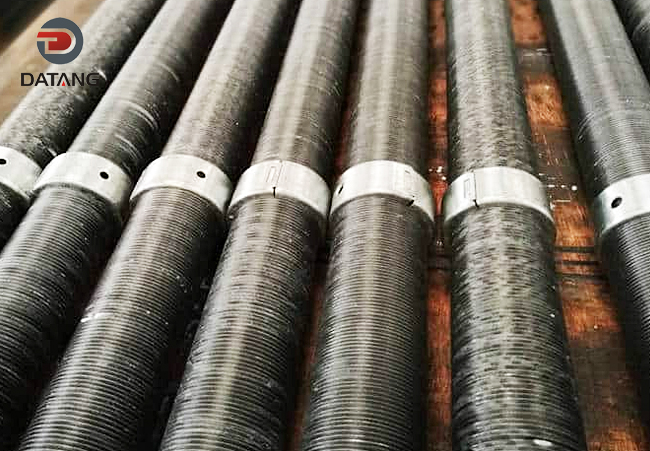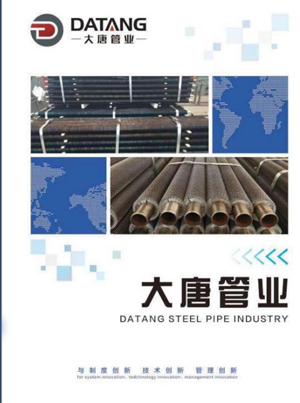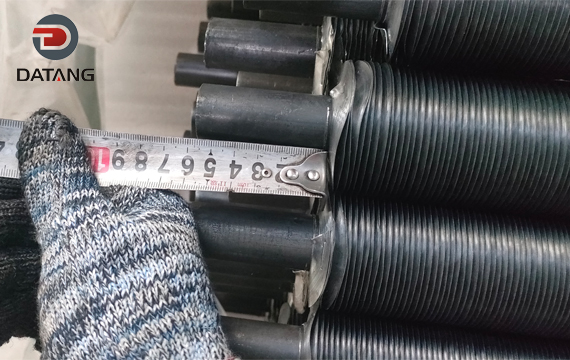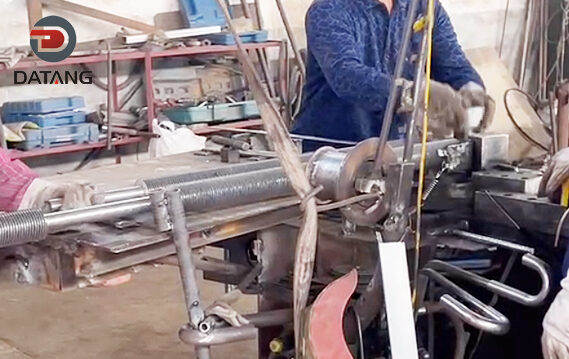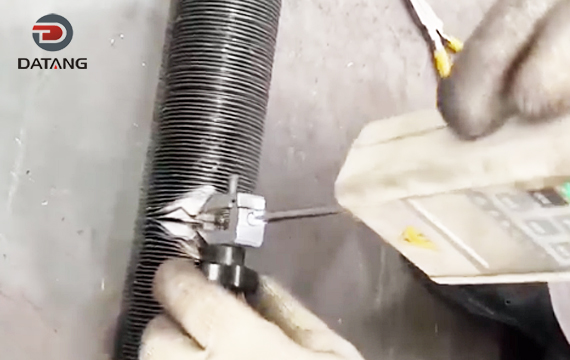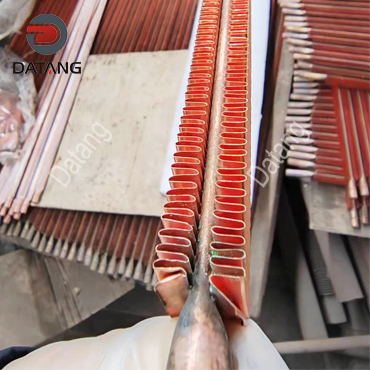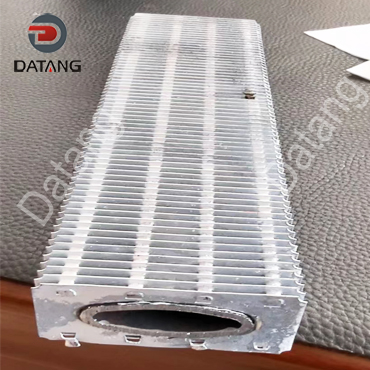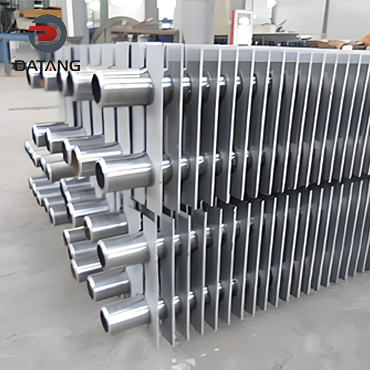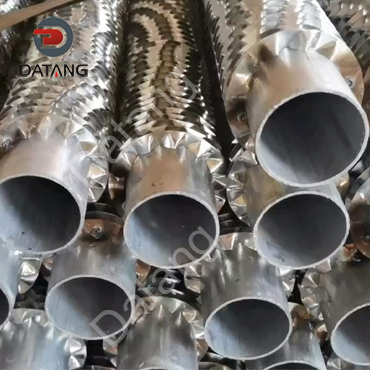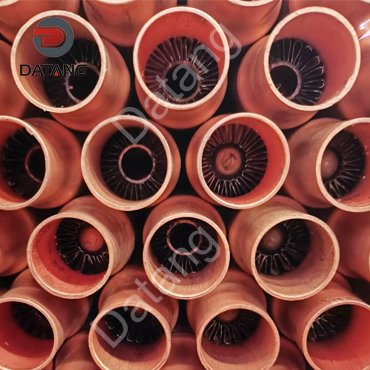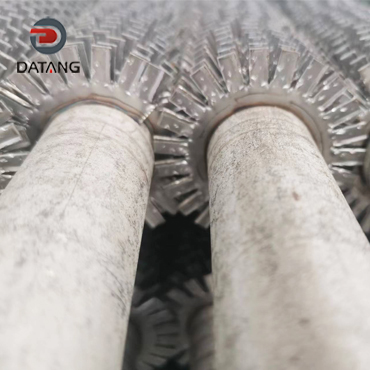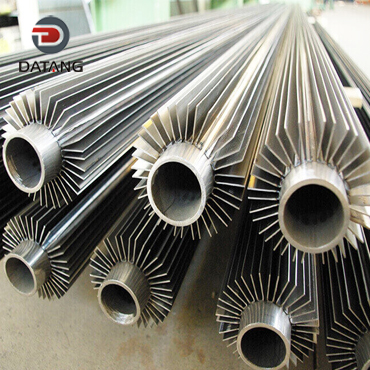Embedded Fin Tube,G Type Finned Tube: SA214 Embedded Finned Tube G-Type Al Fin
The SA214 Embedded Finned Tube G-Type Al Fin is a high-efficiency heat exchange element. Its core structure consists of a base tube and aluminum fins bonded together through a special process.
- Tube Material:Carbon steel,Stainless steel,Tube Diameter:15.88-50.80 mm,Wall Thickness:1.0-3.0 mm
- Fin Material:Aluminum,Cooper,Fin Thickness:0.4-0.5 mm,Fin Pitch:2.1-6.0 mm,Fin Height:6.35-25.4 mm
SA214 Embedded Finned Tube G-Type Al Fin Structural Design
Base Tube and Fin Material Selection
Base tube: Typically made of carbon steel (such as SA214 standard steel tube) or stainless steel, it serves as a heat transfer channel and must be pressure-resistant and corrosion-resistant, meeting a pressure resistance of ≥1.5 MPa.
Aluminum fins: High-purity aluminum (≥99.5%), 0.2-0.5 mm thick, is used. Bonded to the base tube through an embedded process, aluminum’s high thermal conductivity (237 W/(m・K)) significantly improves heat dissipation efficiency, ensuring a thermal conductivity of ≥200 W/(m・K).
Embedded Process
Embedded Process: Spiral grooves are machined into the steel tube surface, and then aluminum strips are embedded. Preload is used to ensure close contact and reduce thermal resistance.
Substrate Tube Pretreatment:
The substrate tube undergoes pickling (hydrochloric acid concentration 15%-20%) to remove the oxide layer, followed by sandblasting (80-120 mesh) to increase surface roughness and enhance bonding strength.
Fin Forming and Embedding:
Aluminum strip is extruded through a dedicated die into spiral or straight fins. These fins are then embedded into pre-machined grooves on the substrate tube surface using high-frequency welding (200-400kHz) or mechanical embedding. Bond strength must be ≥30MPa.
SA214 Embedded Finned Tube G-Type Al Fin Quality Inspection Standard
Sealing Test: A water pressure test (1.2-1.5 times the operating pressure) ensures leak-free operation.
Thermal Performance Test: The contact thermal resistance between the fin and the base tube is ≤0.1°C·cm²/W, improving heat transfer efficiency by 30%-50%.
SA214 Embedded Finned Tube G-Type Al Fin Performance Advantages
High-Efficiency Heat Transfer: The fins expand the heat dissipation area by 3-10 times, making them suitable for space-constrained applications (such as electronic equipment cooling).
Lightweight: Aluminum weighs only one-third of steel, making it suitable for weight-sensitive applications.
Corrosion Resistance: Stainless steel or galvanized base tubes are suitable for corrosive environments such as chemical and marine environments.
SA214 Embedded Finned Tube G-Type Al Fin Applications
Industrial Applications: Petrochemical condensers, waste heat recovery in power systems.
Civilian Applications: Air conditioning evaporators, agricultural greenhouse temperature control.
Typical Applications: High-temperature environments (≤200°C) such as chemical condensers and waste heat recovery systems.
SA214 Embedded Finned Tube G-Type Al Fin Comparison with Other Finned Tubes
Compared to high-frequency welded steel fin tubes, aluminum fin tubes offer better thermal conductivity but lower temperature resistance (≤200°C).
Compared to rolled aluminum fin tubes, the inlay process offers higher bond strength but slightly higher cost.
SA214 Embedded Finned Tube G-Type Al Fin Process Comparison
High-frequency welding: Suitable for mass production, low cost, but requires controlled welding distortion.
Integrally rolled: No weld seams, higher heat transfer efficiency, but requires higher equipment investment.
- Datasheet
- Drawing
- Certificates
| Tube Material | Wall Thickness | Tube Diameter | Tube Length |
| All types | From 1.0 to 3.0 mm | 15.88 / 50.80 mm | Max. 18500 mm |
| 0.039 in to 0.118 in | 0.625 / 2 in | 728 in | |
| Fin Strip Material | Fin Strip Thickness | Fin Pitch | Production Capacity |
| Aluminum/Copper | From 0.4 to 0.5 mm | From 2.1 to 3.0 mm | 12000 m per day |
| From 0.015 to 0.019 in | From 8 to 11 fins/inch |


Embedded Fin Tube Appearance Dimension Inspection
Embedded fin tube appearance dimension inspection is one of the important links to ensure the quality and performance of fin tubes.
The inspection items mainly include fin height, fin spacing, fin thickness, base tube wall thickness and outer diameter, etc.
Datang Embedded Fin Tube Bending Processing
Bending of fin tubes is an important step in the production process of G type fin tubes. Bending is to bend the embedded fin tube material through specific mechanical equipment to form a suitable curvature to meet different usage requirements.
This step requires strict control of the bending angle and curvature to ensure the fit between the fin and the base tube and the heat dissipation effect.
G Type Embedded Finned Tube Pull Off Test
G type embedded finned tube pull-off test is a test used to detect whether the fin tube will fall off when subjected to tension, mainly used to ensure the quality and reliability of the fin tube.
Datang’s this test is very important in the production process because the g type finned tubes will be subjected to various stresses during operation, such as temperature changes and pipe expansion, which may cause the fin to fall off, thereby affecting the performance and safety of the heat exchanger .







